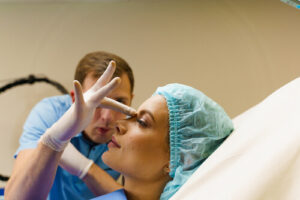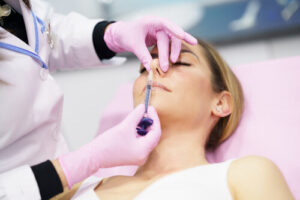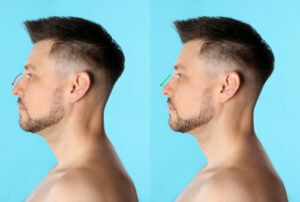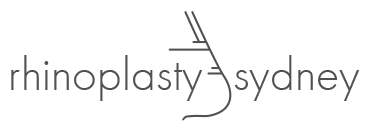Experiencing a ‘piggy nose’ after rhinoplasty can be distressing for patients expecting a flawless outcome from their surgery. This term refers to an overly upturned nose, which may create an unintended, less natural appearance. In this article, we delve into why a piggy nose might occur post-rhinoplasty and discuss the available corrective measures.
Stay tuned as we uncover insights from leading plastic surgeons on addressing this issue. We want to ensure that your journey towards perfecting your nasal profile leads to satisfaction and confidence in your appearance.
Understanding Piggy Nose: Definition and Causes Post-Rhinoplasty

Surgical Techniques
The primary cause of a piggy nose is related to the surgical techniques employed during rhinoplasty. If the surgeon lifts the tip too high or removes too much support from the tip cartilage, it can lead to an unnatural, upturned look.
Healing and Individual Anatomy
Variations in the healing process and the patient’s unique nasal anatomy also play significant roles. How the nasal tissues heal and integrate the surgical changes can affect the final appearance. The nasal skin and soft tissue may sometimes contract during healing, pulling the tip upward.
Surgeon Experience
The surgeon’s expertise is crucial. An inexperienced surgeon may need to adequately account for how surgical modifications will look post-healing, leading to an undesirable outcome.
Common Surgical Techniques and Why They Might Result in a Piggy Nose
A piggy nose outcome after rhinoplasty, characterised by an overly upturned nasal tip, can sometimes occur due to specific surgical techniques or decisions during the cosmetic procedure. Understanding these techniques and why they might lead to such results is crucial for both patients and surgeons aiming to avoid this undesirable outcome. Here are some common surgical techniques associated with the development of a piggy upturned nose rhinoplasty:
Excessive Cartilage Removal: One of the primary causes of a piggy nose is the over-resection of the lower lateral cartilage. These cartilages support the nasal tip, and removing too much can cause the tip to rotate upwards excessively, leading to an unnatural, upturned appearance.
Improper Tip Rotation Techniques: During rhinoplasty, surgeons may attempt to rotate the tip to correct a drooping nose and enhance facial symmetry. However, if the rotation is overdone, it can elevate the tip too much, creating a piggy nose effect. This is often a result of not accurately predicting the degree of tip rotation needed or not considering the skin’s and soft tissues’ natural elasticity, which might lead to further elevation post-surgery.
Inadequate Support Structures: After modifying or removing cartilage, it’s crucial to ensure the tip has sufficient structural support to maintain its new nasal shape. Failure to provide adequate support, such as not using enough cartilage grafts to reinforce the nasal tip, can allow the tip to drift upwards as the nose heals.
Tension in the Skin and Soft Tissues: The skin and soft tissues of the nose can react unpredictably to the underlying structural changes. In some cases, the natural contracture of the healing tissues can pull the nasal tip upward, especially if the skin is tightly redraped over the tip without sufficient allowance for healing and settling.
Use of Inappropriate Techniques for a Specific Nasal Anatomy: Each rhinoplasty should be tailored to the patient’s unique facial structure. Techniques that work well for one type of nasal anatomy might not be suitable for another. For example, techniques that involve significant lifting of the tip might be appropriate for a nose with a pronounced droop but could lead to a pig nose in patients whose nasal tips initially require less adjustment.
Coping Strategies

Seek Professional Counseling: Psychological counselling can be beneficial for patients struggling with the emotional aftermath of rhinoplasty. Therapists can help patients rebuild self-esteem and adjust to their new appearance.
Join Support Groups: Connecting with others who have had similar experiences can provide emotional support and valuable insights into managing expectations and outcomes.
Allow Time for Adjustment: Sometimes, the initial shock of change is the main cause of distress. Allowing time to adjust to the new appearance and waiting for the swelling to subside fully can change the patient’s perspective on the outcome.
Corrective Measures: Options for Revising a Piggy Nose Deformity

Understanding the available corrective measures can guide you towards a satisfying resolution if you deal with this complication. Here are the main options for revising a piggy nose deformity:
Revision Rhinoplasty
Primary Approach: This surgical procedure is typically the most comprehensive solution for correcting a piggy nose. The surgeon may use grafting techniques to lengthen the nasal tip and decrease its upward tilt. Cartilage grafts, often taken from the septum, ear, or ribs, can rebuild the nasal structure and provide a more natural angle.
Refinement Techniques: Minor adjustments involve repositioning the nasal tip cartilage or adding support to the columella, the structure between the nostrils, to drop the tip to a more natural position.
Injectable Fillers
Non-Surgical Option: Injectable fillers offer a temporary solution for less severe cases or patients wary of undergoing another surgery. They can be used to add volume around the nasal base to counteract the excessive rotation of the tip.
Limitations: Fillers are temporary and require regular maintenance. Additionally, they cannot address all structural issues as effectively as surgery.
Use of Dermal Fillers
Immediate Adjustments: In some cases, dermal fillers can be strategically injected to camouflage the appearance of the piggy nose by altering the contours around the nasal tip and bridge. This method is less invasive and can serve as an interim solution while considering further surgical revision.
Laser Resurfacing and Tightening
Skin Adjustment: If the piggy nose appearance is partly due to tightened or overly retracted skin, laser treatments might help by resurfacing the skin and promoting a slight relaxation of the tissues.
Consultation with a Specialist
Expert Assessment: It is crucial to consult with a facial plastic surgeon specialising in revision rhinoplasty. These specialists can provide a detailed assessment and tailor a surgical plan that addresses aesthetic concerns and functional issues, like breathing difficulties, that might accompany structural deformities.
Preventing Piggy Nose: Tips for Patients Considering Rhinoplasty

Select a Qualified Surgeon: Ensure your surgeon specialises in rhinoplasty and is board-certified in facial plastic or plastic surgery. Review their before and after photos to assess their expertise.
Detailed Consultation: Communicate your aesthetic goals and use imaging technology, if available, to visualise potential outcomes. Discuss surgical techniques and express concerns about potential deformities, like a piggy nose.
Understand the Procedure: Familiarise yourself with the surgeon’s techniques, especially how they plan to handle the nasal tip and use grafting to prevent undesirable outcomes.
Postoperative Care: Follow the surgeon’s post-surgery care instructions meticulously to support proper healing and avoid complications that could alter the surgical results.
Set Realistic Expectations: Individual healing variations can affect the final appearance. Prepare for an adjustment period and communicate openly with your surgeon for follow-up evaluations.
In conclusion, addressing a piggy nose after rhinoplasty is crucial for patients seeking to achieve their desired aesthetic outcomes. Understanding the surgical causes and the corrective options available can significantly ease concerns and lead to successful resolution. If you’re experiencing dissatisfaction with a piggy nose deformity post-surgery, consult a skilled plastic surgeon specialising in rhinoplasty revisions. You can correct this issue with the right approach and feel more confident and pleased with your nasal appearance.
If you’re concerned about a piggy nose after rhinoplasty and seek expert advice and treatment options for optimal nasal function, don’t hesitate to reach out. Call us at (02) 8880 9037 to schedule a consultation with our experienced team at AU Rhinoplasty Sydney. Take the first step towards correcting your nasal profile and restoring your confidence today!
References
Upturned Nose: Do You Need to Correct It?
https://www.healthline.com/health/upturned-nose
Vertical Alar Lengthening Technique in correcting short noses
https://pubmed.ncbi.nlm.nih.gov/37437336/
Over-Rotated Nasal Tip
https://www.researchgate.net/publication/352494732_Over-Rotated_Nasal_Tip
Rhinoplasty (Nose Job): Surgery, Recovery, Before & After
https://my.clevelandclinic.org/health/treatments/11011-rhinoplasty
Rhinoplasty – Mayo Clinic
https://www.mayoclinic.org/tests-procedures/rhinoplasty/about/pac-20384532


Recent Comments